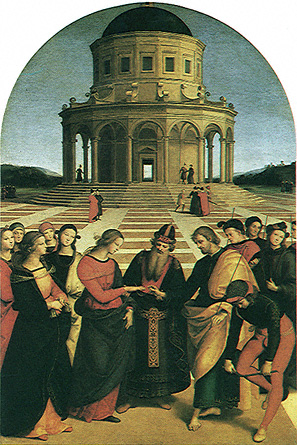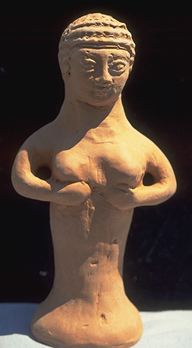Mary as Goddess: Bride

|
“Let him kiss me with
the kisses of his mouth! More delightful is your love than wine!
Your name spoken is a spreading of perfume — that is why the
maidens love you. Draw me — We will follow you eagerly! Bring
me, O King, to your chambers.”
–Song of Songs 1:1-4
|
Spiritual Marriage
The archetype of Spiritual Marriage is present in nearly every religion
in the historical record through the present day, and the Bible is no
exception. Bride and Bridegroom imagery pervades both the Old and New
Testaments. One of the most popular passages in the Old Testament, The
Song of Songs (also known as The Song of Solomon) is a joyful
celebration of erotic love. This passage is strongly associated with
Mary, and is read on her feast days. How did the Blessed Virgin become
associated with physical love? How did the Mother of Christ become the
Bride of Christ? We will explore these questions here.
The Bride of Christ
The Bride of God in the Old Testament
The Sacred Marriage & Ancient Goddesses
Mary & Love Goddesses
References
The Bride of Christ
In light of the knowledge that ancient goddesses often had a Mother/Lover
relationship to their Divine Sons, perhaps the notion of Mary as both
Mother & Bride of Christ shouldn’t seem strange. But Christianity diverges
from the Old Religions most sharply in its denial of sexuality. Isn’t
it extraordinary, then, that Mary, celebrated for her lack of sexuality,
has come to claim the title of Bride, just as the ancient goddesses
did? How did this happen?
Modern devotees of
Mary Magdalene are convinced that Jesus was married to and fathered
a child with the Magdalene, his earthly bride. Evidence suggests that
The Song of Songs celebrated Mary Magdalene in early Christianity,
not Mother Mary. But after worship of the Magdalene was suppressed,
all devotions to her were officially transferred to Mother Mary. This
is one theory.
Another theory suggests that the ancient definition of
Virgin was retained in cultural consciousness. An ancient virgin
was not celibate, only autonomous, and thus many of the
ancient love goddesses were also hailed “Virgin.”
| Added to this is the Spiritual archetype of Marriage, an archetype which reflects a union of separate parts (separate selves) into a whole, a union of Self with The Divine. It is this definition of Spiritual Marriage that the orthodox Church claims in endowing Mary with the title “Bride of Christ.”
However, Mary was viewed as a real-life bride too, the bride of Joseph, as this painting “Marriage of the Virgin” affirms. Perhaps more than any other factor, it was the need for real-life spiritual models that molded Mary into a Bride.
Regardless of the reasons, in 370 Ambrose officially identified Mary as the Bride in The Song of Songs, linking her with Paul’s symbol of The Christian Church as Bride (A, B). The title “Bride of Christ” was soon extended to nuns and to each Christian’s soul (B). Thus, both Christ and Mary became Spiritual Lover. |

|
The Bride of God in the Old Testament
Hosea, Jeremiah, Ezekiel, and Isaiah all describe Israel, The Chosen People,
as The Bride of Yahweh/Jehovah. These prophets paint God as Divine Husband,
at times angry and jealous, at times loving and joyous (B). The Israelites
were surrounded with images of a Divine Husband and Wife from the “heathen”
cultures around them. The Goddess “Asherah (sometimes
called Ashtoreth, Astarte, or Anat) and her Divine Consort, Baal, appear
multiple times throughout the Old Testament as the Israelite prophets seek
to eradicate their influence — not very successfully, judging from their
own accounts.
|

Asherah
from Sacred Source
size=3>
|
Strong archeological evidence suggests
that the Israelites incorporated Asherah into Judaism, worshiping
her as Wife of Yahweh (B, C, D *). In fact, the Biblical record
shows that Solomon encouraged worship of Asherah in the Jerusalem
temple:
The king defiled the high places
. . . which Solomon, king of Israel, had built in honor of Astarte
. . .
Then the king commanded the high priest . . . to remove from
the temple of the Lord all the objects that had been made for
Baal, Asherah, and the whole host of heaven . . . . From the
temple of the Lord he also removed the sacred pole [a symbol
of Asherah] . . . . and tore down the apartments . . . which
were in the temple of the Lord and in which the women wove garments
for the Asherah.
II Kings 23:13; 4-7
|
The Sacred Marriage & Ancient Goddesses
Heiros Gamos, the Sacred Marriage, was an ancient ceremony in which
a king must wed The Goddess symbolically through a priestess. Thus the King
gained power to rule the land, and the fertility of the land was ensured.
| Through participating in the ritual, the king agreed to sacrifice his life for his people. Sometimes the king’s life was called for, and he was ritually sacrificed.
In some of the oldest surviving literature, written on clay tablets in Sumeria, the rite of Heiros Gamos is described (E). The rite includes mourning the dead king, recalling images of the Pieta, shown here. Mary Magdalene is associated with this rite as well (F).
|

|
Mary & Love Goddesses
In the age of the Troubadours, Mary was praised as the object of courtly
love, the untouchable beauty to be praised above all others (B). Many
paintings of this era portrayed Mary as a sensuous woman, like the portrait
shown here. Offerings of love to her were common. One legend tells of
a man who gave Mary a crown of 50 roses every day (G). Multitude songs
of love were written to Mary. St. Anselm addresses her in his Meditations:

|
“Mary, thou art beautiful to gaze
upon, desireable to embrace, delightful to see, for the
greatest joy next to God is to look on thee and to take delight
in thy praises.” (G)
Just as nuns wed Christ, so monks and priests
wed Mary. Hopeful knights were known to place
a ring on Mary’s finger. If the statue gripped the ring firmly,
the knight considered himself her Bridegroom and entered a religious
order. In Greece, men who worshiped Venus performed the same ritual.
Venus was also known to firmly grip the rings of the men she loved.
One Friar, Alain de la Roche, claimed that many saints and angels
witnessed his wedding to Mary who placed on his finger a ring made
of her woven hair (a common love custom at that time.) (H)
|
In addition, Mary shares titles with Love Goddesses.
Aphrodite and Mary are both hailed “Star of the Sea.”
Mary and Venus share the title “Morning Star.”
Inanna (the primary Goddess of the Sacred Marriage) and Mary are both
“Queen of Heaven.”
References
(A)
Dictionary of Mary
Catholic Book Publishing
(B)
The Once and Future Goddess
By Elinor Gadon
(C)
When God Was a Woman
by Merlin Stone
(D)
The Once and Future Goddess
By Elinor Gadon
(E)
Inanna: Queen of Heaven and Earth
by Diane Wolkstein
(F)
The Woman with the Alabaster Jar
by Margaret Starbird
(G)
Miracles of Mary: Apparitions, Legends, and Miraculous Works of the
Blessed Virgin Mary
by Michael S. Durham
(H)
The Woman’s Encyclopedia of Myths and Secrets
By Barbara Walker
( * ) And numerous other sources
Visit the Bookstore
Back To Main
Page

|






